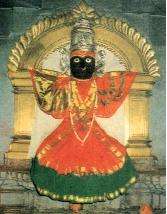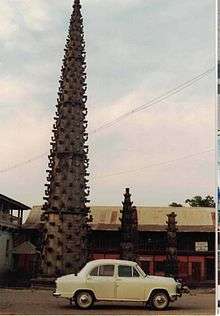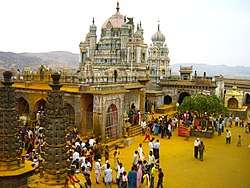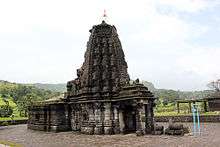Yamai Temple
| Yamai Devi | |
|---|---|
 | |
 Location in Maharashtra | |
| Geography | |
| Coordinates | 17°54′00″N 74°33′00″E / 17.90000°N 74.55000°ECoordinates: 17°54′00″N 74°33′00″E / 17.90000°N 74.55000°E |
| Country | India |
| State | Maharashtra |
| Location | Aundh |
| Culture | |
| Sanctum | Yamai |
| Major festivals | Navratri |
The Yamai Devi Temple (औंध यमाई मंदिर)is situated in a hill complex in the town of Aundh, Satara district, Maharashtra, India.


History
It is said that Goddess Mahalaxmi of Kolhapur and Sri Rama (Lord Vishnu) called her as "Ye Mai" (in Marathi) (ये माय / ये माई) which means "Mother, pls. come" in English. Hence, she is known as Yamai Devi. The top of the hill can either be reached using steps that start at the bottom of the hill or by car using a rather perilous road. Now the vehicles can reach till top as the road conditions have improved. There is a parking available at the top. The idol of Devi Mahishasur Mardini Yamai in black stone is almost 2 meters high and is in a cross-legged sitting position. The temple is the family shrine (kula-daiwat) for a large number of Marathi families. The top of the temple has images and idols of various Hindu deities. The town and the temple has been associated with the Pant family for many centuries.[1] The present head of this former ruling family, Gayatreedevi Pantpratinidhi, has installed a 7 kilograms (15 lb) solid gold kalash or crown on the pinnacle of the Yamai temple on the hill. Another temple of Devi Yamai is located in the town; apart from the one on the hill.
Shri Bhavani Museum
The temple complex also houses the Shri Bhavani Museum established from the private collection of the Maharajas of Aundh. The museum as around half way of the hill where the tourist can reach both by steps and road. The museum holds paintings by noted 19th and 20th century Indian artists such as M. V. Dhurandhar,[2] Baburao Painter, Madhav Satwalekar[3] and Raja Ravi Varma as well as the famous Mother and Child stone structure by the British artist Henry Moore.[4]
References
- ↑ Pant, Apa. A moment in time. Bombay Calcutta Madras New Delhi: Orient Longman. p. 20. Retrieved 20 November 2015.
- ↑ Bhagwat., Nalini. "M. V. Dhurandhar". indiaart.com. Retrieved 23 December 2014.
- ↑ Chaitanya, Krishna (1994). A History of Indian Painting: The modern period. New Delhi: Abhinav Publications. pp. 273–274. ISBN 81-7017-310-8.
- ↑ "Shivaji designs for stained-glass windows: the art of Ervin Bossanyi. - Free Online Library". Thefreelibrary.com. Retrieved 2013-05-09.

